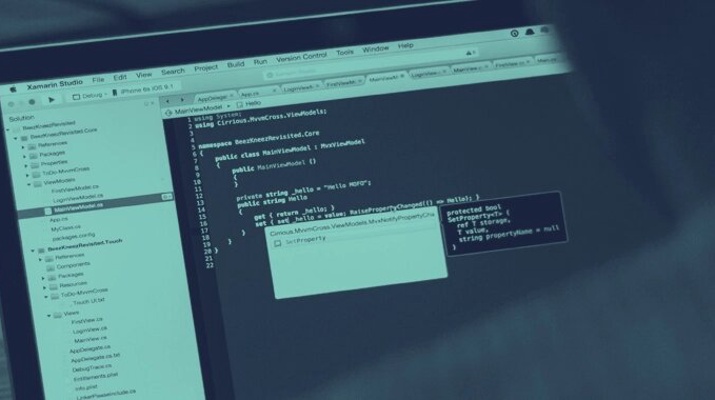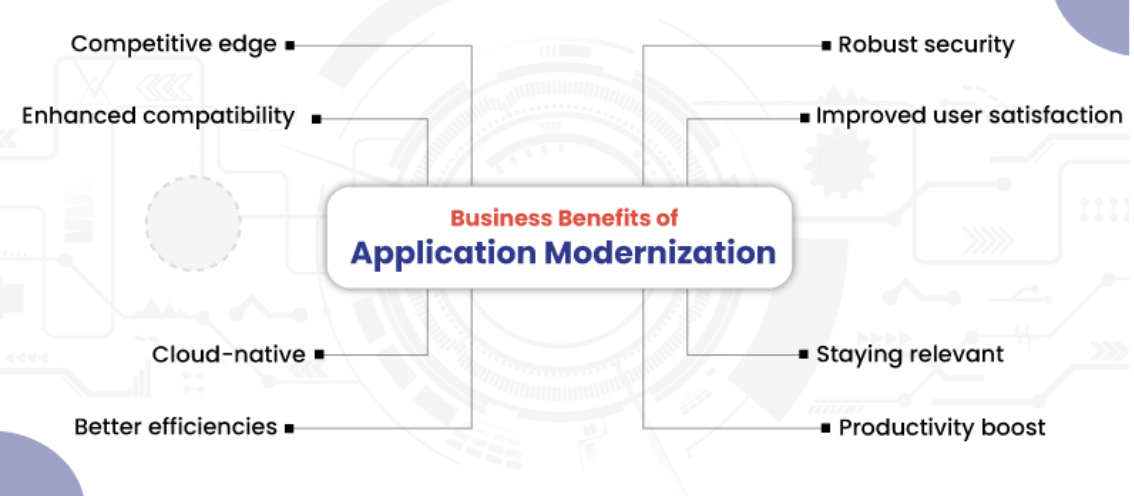Legacy to Leading Edge: Unleashing Business Potential through Application Modernization

Legacy to Leading Edge: Unleashing Business Potential through Application Modernization
Unlock the true power of your business with cutting-edge application modernization, paving the way from legacy systems to the forefront of innovation and success. Experience a transformative journey as outdated constraints are shattered and your company emerges as a leader in the digital age.
Are you tired of feeling like a business fossil? It's time to ditch your outdated technologies and join the cool kids in the land of cutting-edge innovation.
Prepare to revolutionize your business with legacy application modernization - the key to unlocking unprecedented efficiency and groundbreaking innovation.
Say goodbye to sluggish systems, security vulnerabilities, and outdated workflows, and say hello to a future where productivity soars, customer satisfaction skyrockets, and profits surge.
Buckle up as we embark on a thrilling journey through legacy application modernization, where transformation and success await.
Find the perfect software development company for your needs on The Manifest.
What Does Legacy Application Modernization Mean Exactly?
Legacy Application Modernization is the strategic process of updating and enhancing outdated software systems to align with the current technological landscape. It involves assessing the existing application architecture, identifying areas of inefficiency, and implementing targeted improvements.
This may include refactoring or rewriting code, integrating modern technologies, optimizing performance, enhancing security measures, and improving user experiences.
Legacy application modernization aims to overcome legacy systems' limitations, such as outdated programming languages, obsolete frameworks, and complex dependencies.
By leveraging modern software development practices and adopting industry-standard technologies, businesses can achieve greater scalability, flexibility, and maintainability.
Benefits of Legacy Application Modernization
When you embark on the modernization journey of your applications, a world of benefits awaits your business. Here are the cream advantages you get with legacy application modernization:
1. Enhancing Business Efficiency & Productivity
Modernizing your applications unlocks the potential for enhanced efficiency and productivity. Outdated systems often need faster performance, more convenient processes, and more functionality.
Through modernization, you can optimize workflows, streamline operations, and automate repetitive tasks. This results in improved employee productivity, reduced manual effort, and faster time-to-market for new features and updates.
2. Improving User Experience & Customer Satisfaction
Modernizing applications allows you to revamp the user interface, improve usability, and introduce intuitive features. By incorporating modern design principles and responsive layouts, you create a seamless and engaging user experience. This, in turn, enhances customer satisfaction, fosters loyalty, and drives repeat business.

Source: Veritis
3. Improved Ability to Scale & Adapt Quickly
Legacy applications often need help accommodating growing business needs and changing market demands. Modernizing your applications empowers you to embrace scalable architectures and agile development methodologies.
By leveraging cloud computing, microservices, and containerization, you can effortlessly scale your applications to handle increased workloads and adapt to evolving business requirements. This flexibility enables you to seize new opportunities, respond swiftly to market changes, and stay ahead of the competition.
4. Saving Costs in The Long Run
While the initial investment in application modernization may seem intimidating, it offers significant cost savings in the long run.
Outdated systems often require extensive maintenance, inefficient resource allocation, and pose security risks. Modernizing can reduce maintenance efforts, optimize resource utilization, and fortify your applications against potential threats.
Furthermore, the enhanced efficiency and productivity gained through modernization result in operational cost reductions and increased revenue generation.
Practical Approaches To Modernize Legacy Applications
By implementing the strategic approaches, you set yourself on the path to a successful Legacy Application Modernization and prepare to witness the transformation of your legacy systems into efficient and future-ready applications that drive your business forward.

Source: Ace Infoway
- Assessment and analysis of current legacy systems: Before embarking on the modernization process, it is essential to thoroughly assess and analyze your current legacy systems. This involves identifying your existing applications' strengths, weaknesses, and bottlenecks. Through comprehensive analysis, you gain insights into the areas that require modernization and understand the impact on your business operations.
- Prioritization and goal setting: With a clear understanding of your legacy systems, it's crucial to prioritize your modernization efforts. Determine the areas that will yield the highest return on investment and align with your business goals. By setting clear priorities, you can focus your resources and efforts on the most critical aspects of modernization.
- Development of a modernization roadmap: To ensure a structured and organized approach to modernization, develop a roadmap that outlines the step-by-step process. The roadmap should include key milestones, timelines, and resource allocation. It serves as a guiding document, ensuring all stakeholders are aligned and aware of the strategic direction.
- Choosing the right modernization approach: Legacy Application Modernization can be approached through various techniques, such as rehosting, re-platforming, refactoring, or rebuilding. Assess your requirements, technical feasibility, and budgetary constraints to determine the most suitable approach for your applications. Each process has advantages and considerations, so make an informed decision based on your unique circumstances.
- Integration of cloud-based solutions: Leveraging cloud-based solutions is a powerful strategy for modernizing legacy applications. Cloud computing offers scalability, flexibility, and cost-effectiveness. You can use on-demand resources, automated scaling, and seamless integration with other cloud services by migrating your applications to the cloud. This unlocks new possibilities and lays the foundation for future growth.
- Adoption of agile development methodologies: To ensure a successful modernization journey, embrace agile development methodologies. Agile methodologies, such as Scrum or Kanban, emphasize iterative and collaborative approaches to software development. They promote faster delivery, continuous feedback, and adaptability to changing requirements. Agile practices empower your teams to respond to evolving business needs, maximize productivity, and deliver value incrementally.
Collaborative Strategies for Sustainable Success in Enhancing Legacy Application Modernization
Unlocking the full potential of Legacy Application Modernization hinges upon the strategic implementation of indispensable best practices. These critical guidelines pave the way for a triumphant and enduring transformation.

Source: Convergeone
1. Facilitating Collaboration Between IT and Business Stakeholders
- Legacy application modernization is a collaborative effort that requires strong alignment between IT and business stakeholders. Establishing effective communication channels and fostering collaboration is essential.
- By involving key stakeholders from both technical and business domains, you ensure that modernization efforts are aligned with the organization's overall strategic objectives. This collaboration allows for a deeper understanding of business requirements, facilitates the identification of critical functionalities, and ensures that modernized applications deliver tangible value.
- Moreover, Mr. Roth, VP-Research at Gartner, mentions that decision-makers now recognize that more than relying on a single vendor is required. They understand the need for a foundational platform but acknowledge that only some vendors can fulfill all their collaboration requirements. This shift leads to collaboration services evolving into infrastructure services, a positive development.
2. Ongoing Monitoring and Evaluation
- Modernization is not a one-time event; it is an ongoing process. Continuous monitoring and evaluation play a vital role in ensuring the success of modernized applications. Implement monitoring mechanisms to track the modernized systems' performance, usability, and user satisfaction.
- According to a report by AppDynamics, companies that effectively monitor and evaluate their modernized applications experience a 50% reduction in application downtime incidents and a 40% increase in customer satisfaction.
- Leverage tools and techniques for automated monitoring, logging, and analytics to gather valuable insights. Regularly evaluate the impact of modernization efforts, identify areas for improvement, and adapt strategies accordingly to optimize the performance and efficiency of the modernized applications.
3. Employee Training and Upskilling
- Modernizing legacy applications often introduces new technologies, frameworks, and development methodologies. Invest in training and upskilling programs for your employees to maximize the benefits of modernization. Provide them with the necessary knowledge and skills to effectively work with modernized systems. Training can encompass new programming languages, cloud platforms, DevOps practices, and agile methodologies. This empowers your workforce to adapt to the changes, utilize the full potential of the modernized applications, and contribute to the ongoing success of your organization.
- Over and above this, a collaborative study conducted by the World Economic Forum in partnership with PwC reveals that dedicating resources to the reskilling and upskilling of the existing global workforce holds the potential to stimulate the global GDP by an impressive $6.5 trillion by the year 2030.
4. Continual Maintenance and Support
- Even after successful modernization, applications require ongoing maintenance and support to ensure optimal performance and longevity. Establish a dedicated team responsible for monitoring, maintaining, and supporting modernized applications. Regularly apply updates, security patches, and bug fixes to keep the systems secure and up to date. Implement robust incident management and support processes to address any issues promptly. By providing ongoing maintenance and support, you ensure the longevity and reliability of the modernized applications, enabling your business to leverage its full potential.
5. Conquer the Obstacles of Migrating
- Migrating a legacy system poses several challenges. Budgeting is crucial, considering the costs of cloud/software, implementation, hardware upgrades, and employee training. Time management requires prioritizing critical processes before migration. User acceptance can be addressed through effective communication and addressing concerns. Data migration needs a comprehensive plan and backup strategy. Identifying dependencies ensures proper arrangements. Pre- and post-migration planning helps manage the process effectively and prevent issues. Post-migration, checking data, support channels, knowledge base links, templates, integrations, and conducting efficient testing is essential.
Legacy Application Modernization: Finding the Ideal Timing
Legacy Application Modernization is worth considering when outdated technologies and processes impede business efficiency, pose security risks, limit integrations, and hinder scalability. Here is a short checklist for when you should opt for legacy application modernization.
- Outdated technology hindering business efficiency
- Increased maintenance and security risks
- Inability to integrate with modern systems
- Lack of scalability and agility
- Potential cost savings in the long run
With the potential for cost savings, modernization can pave the way for improved business outcomes. It’s time to seize the moment, embrace innovation, and propel your business to greater heights.
Collaborating with a suitable software development company in application modernization can ensure the continuous upkeep of your software systems. Such companies possess the expertise to deliver timely software updates and security patches, facilitating a seamless transition to newer software versions whenever required.
The most effective approach for modernizing legacy applications depends on the specific challenges you aim to address and the level of support you desire.
Revitalizing Business Potential Through Modernization
In a world where businesses once struggled with clunky legacy systems, a new era has dawned with the power of application modernization. Say goodbye to outdated constraints and hello to a transformative journey of innovation and success. As your company sheds its old skin, it emerges as a leader in the digital age, leaving competitors in awe and admiration.
With each step forward, you leave behind obsolete technologies and gain superpowers, propelling your business into the sleek and streamlined systems of the future. Customers flock to you like moths to a dazzling digital flame, while others are left in the dust, clinging to outdated methods of communication.
Embrace application modernization and watch your business soar because, in this tale of underdog-turned-digital-superhero, the choice is clear: join the leading edge or be left behind like a vinyl record in a world of Spotify playlists.
Find the best software development companies on The Manifest.